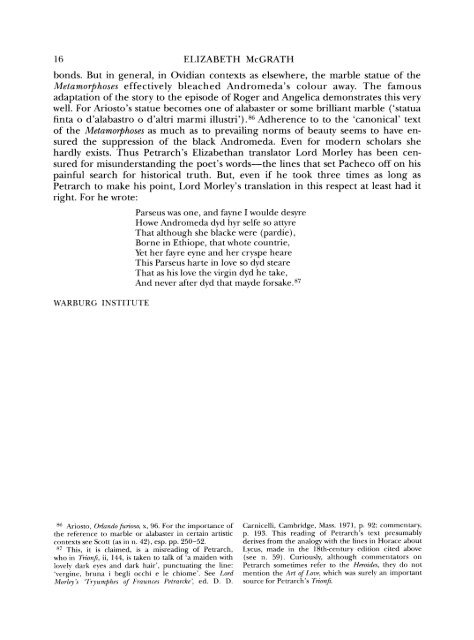The black andromeda.pdf - camberwellmastudents
The black andromeda.pdf - camberwellmastudents
The black andromeda.pdf - camberwellmastudents
You also want an ePaper? Increase the reach of your titles
YUMPU automatically turns print PDFs into web optimized ePapers that Google loves.
16 ELIZABETH McGRATH<br />
bonds. But in general, in Ovidian contexts as elsewhere, the marble statue of the<br />
Metamorphoses effectively bleached Andromeda's colour away. <strong>The</strong> famous<br />
adaptation of the story to the episode of Roger and Angelica demonstrates this very<br />
well. For Ariosto's statue becomes one of alabaster or some brilliant marble ('statua<br />
finta o d'alabastro o d'altri marmi illustri').86 Adherence to to the 'canonical' text<br />
of the Metamorphoses as much as to prevailing norms of beauty seems to have ensured<br />
the suppression of the <strong>black</strong> Andromeda. Even for modern scholars she<br />
hardly exists. Thus Petrarch's Elizabethan translator Lord Morley has been censured<br />
for misunderstanding the poet's words-the lines that set Pacheco off on his<br />
painful search for historical truth. But, even if he took three times as long as<br />
Petrarch to make his point, Lord Morley's translation in this respect at least had it<br />
right. For he wrote:<br />
Parseus was one, and fayne I woulde desyre<br />
Howe Andromeda dyd hyr selfe so attyre<br />
That although she <strong>black</strong>e were (pardie),<br />
Borne in Ethiope, that whote countrie,<br />
Yet her fayre eyne and her cryspe heare<br />
This Parseus harte in love so dyd steare<br />
That as his love the virgin dyd he take,<br />
And never after dyd that mayde forsake.87<br />
WARBURG INSTITUTE<br />
86<br />
Ariosto, Orlando furioso, x, 96. For the importance of<br />
the reference to marble or alabaster in certain artistic<br />
contexts see Scott (as in n. 42), esp. pp. 250-52.<br />
87 This, it is claimed, is a misreading of Petrarch,<br />
who in Trionfi, ii, 144, is taken to talk of 'a maiden with<br />
lovely dark eyes and dark hair', punctuating the line:<br />
'vergine, bruna i begli occhi e le chiome'. See Lord<br />
Morley's 'Tryumphes of Fraunces Petrarcke', ed. D. D.<br />
Carnicelli, Cambridge, Mass. 1971, p. 92; commentary,<br />
p. 193. This reading of Petrarch's text presumably<br />
derives from the analogy with the lines in Horace about<br />
Lycus, made in the 18th-century edition cited above<br />
(see n. 59). Curiously, although commentators on<br />
Petrarch sometimes refer to the Heroides, they do not<br />
mention the Art of Love, which was surely an important<br />
source for Petrarch's Trionfi.



